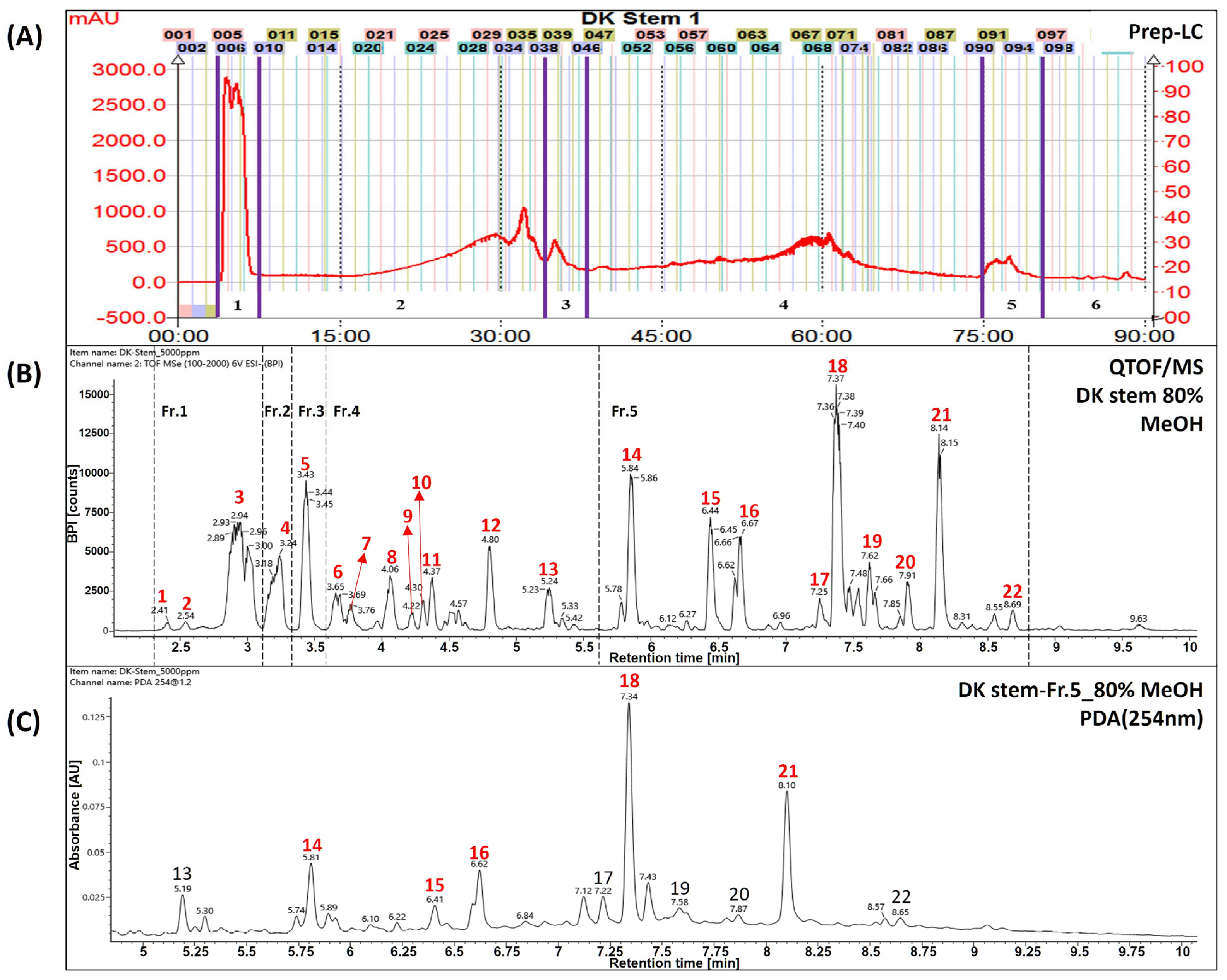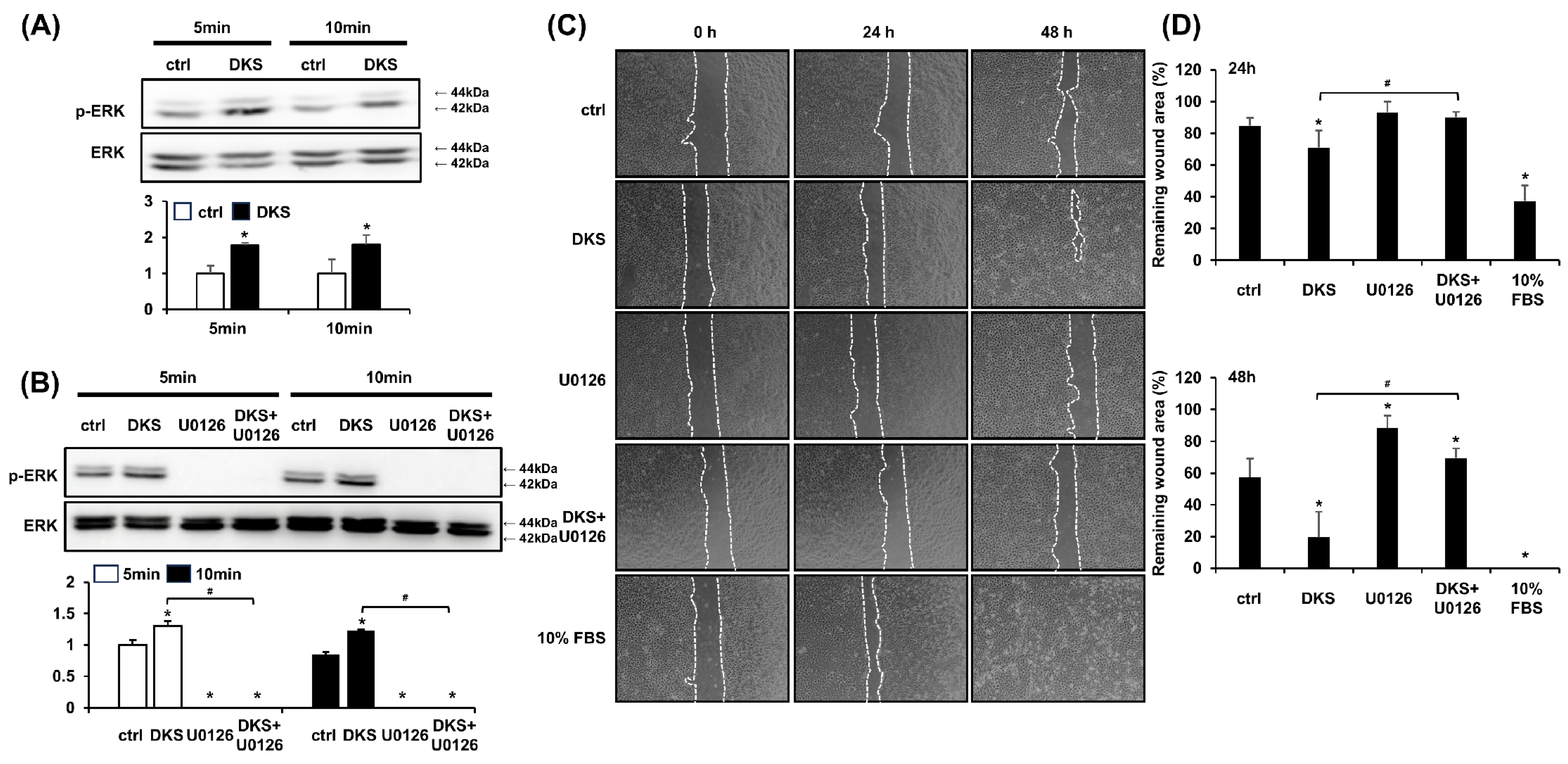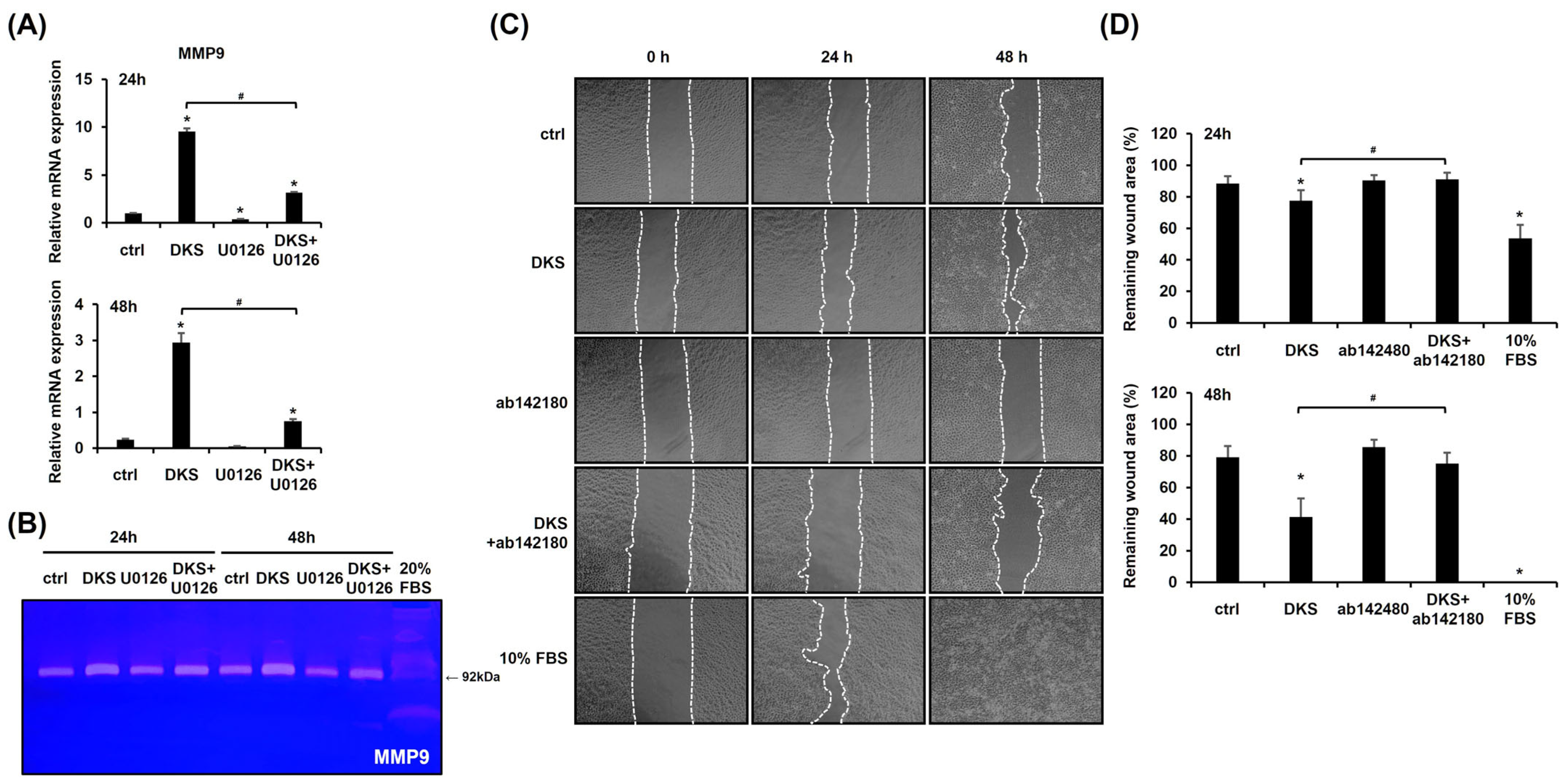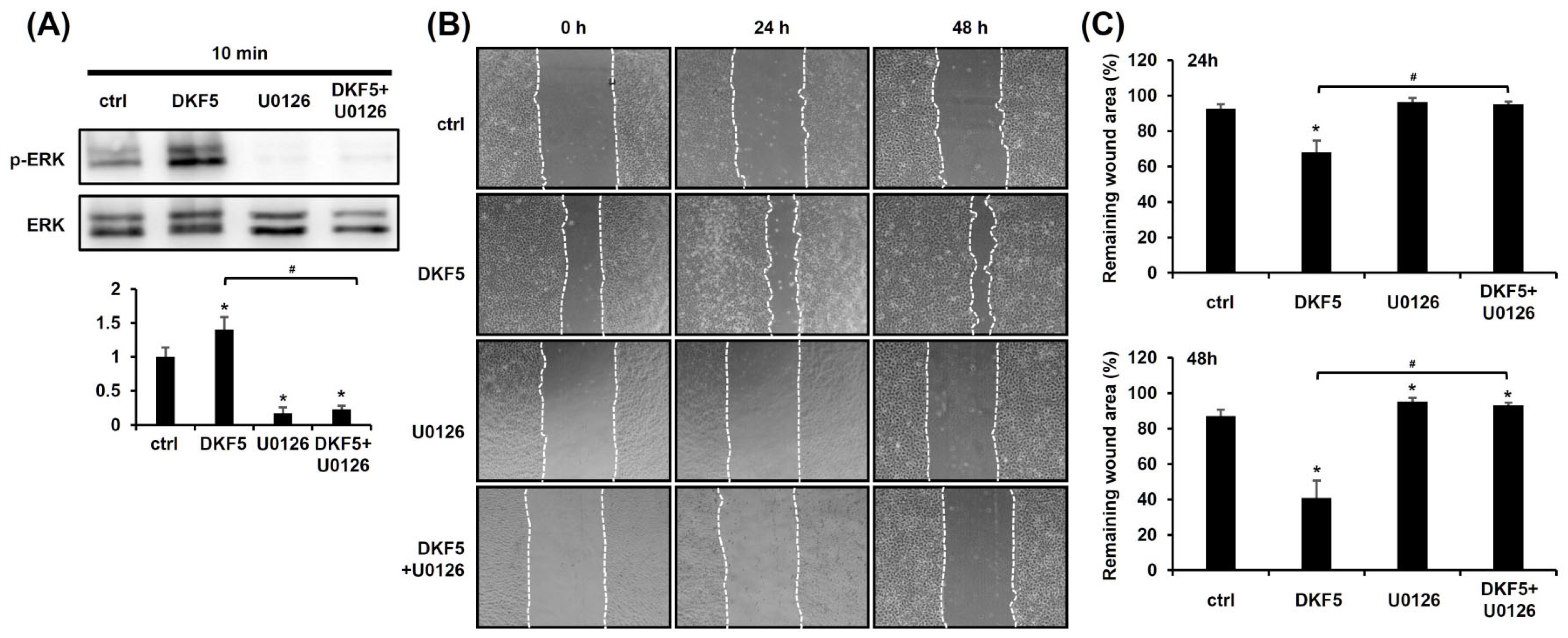Daphne kiusiana Crude Extract and Its Fraction Enhance Keratinocyte Migration via the ERK/MMP9 Pathway
Abstract
1. Introduction
2. Materials and Methods
2.1. Plant Material
2.2. Preparation of Daphne kiusiana Stem Extracts
2.3. UPLC-QToF/MS Conditions
2.4. Reagents
2.5. Cell Culture
2.6. Cell Viability Assay
2.7. In Vitro Scratch Test
2.8. Transwell Migration Assay
2.9. Quantitative Reverse Transcription-Polymerase Chain Reaction (qRT-PCR)
2.10. Western Blot
2.11. Zymography
2.12. Statistical Analysis
3. Results
3.1. Tentative Identification of Main Compounds
3.2. DKS Promoted In Vitro Wound Healing in a Dose- and Time-Dependent Manner
3.3. DKS-Induced Cell Migration Was Attenuated by MEK1/2 Inhibition
3.4. DKS-Induced ERK Activation Upregulates MMP9 Expression, and Its Inhibition Reduces Cell Migration
3.5. DKS Fraction 5 (DKF5) Plays a Major Role in Demonstrating the Migratory Impact of DKS Without Cytotoxicity
3.6. DKF5 Induced ERK Phosphorylation, Leading to Enhanced Cell Migration
3.7. DKF5-Induced ERK Activation Regulates MMP9 Expression, with MMP9 Inhibition Partially Reducing Cell Migration
4. Discussion
5. Conclusions
Supplementary Materials
Author Contributions
Funding
Institutional Review Board Statement
Informed Consent Statement
Data Availability Statement
Acknowledgments
Conflicts of Interest
Abbreviations
| DKS | Daphne kiusiana stem extract |
| DKF5 | Fraction No. 5 of stem extract from Daphne kiusiana |
| EMT | Epithelial-to-mesenchymal transition |
| IL-1β | Interleukin-1beta |
| IL-6 | Interleukin-6 |
| IL-8 | Interleukin-8 |
| MMP-9 | Matrix metalloproteinase-9 |
| TNF-α | Tumor necrosis factor-alpha |
References
- Cho, H.; Blatchley, M.R.; Duh, E.J.; Gerecht, S. Acellular and cellular approaches to improve diabetic wound healing. Adv. Drug Deliv. Rev. 2019, 146, 267–288. [Google Scholar] [CrossRef]
- Zhao, K.; Hu, Z.; Zhou, M.; Chen, Y.; Zhou, F.; Ding, Z.; Zhu, B. Bletilla striata composite nanofibrous membranes prepared by emulsion electrospinning for enhanced healing of diabetic wounds. J. Biomater. Appl. 2023, 38, 424–437. [Google Scholar] [CrossRef]
- Salad, A.M.; Duale, H.A.; Sheikh, I.M.; Hassan, G.D.; Farah, A.A.; Gele, A. Prevalence of diabetes foot ulcers and associated factors among adult diabetic patients in three referral hospitals in Mogadishu, Somalia. Front. Public Health 2023, 11, 1195483. [Google Scholar] [CrossRef]
- Chen, M.; Chang, C.; Levian, B.; Woodley, D.T.; Li, W. Why Are There So Few FDA-Approved Therapeutics for Wound Healing? Int. J. Mol. Sci. 2023, 24, 15109. [Google Scholar] [CrossRef]
- Monika, P.; Chandraprabha, M.N.; Rangarajan, A.; Waiker, P.V.; Chidambara Murthy, K.N. Challenges in Healing Wound: Role of Complementary and Alternative Medicine. Front. Nutr. 2021, 8, 791899. [Google Scholar] [CrossRef] [PubMed]
- Morguette, A.E.B.; Bartolomeu-Goncalves, G.; Andriani, G.M.; Bertoncini, G.E.S.; Castro, I.M.; Spoladori, L.F.A.; Bertao, A.M.S.; Tavares, E.R.; Yamauchi, L.M.; Yamada-Ogatta, S.F. The Antibacterial and Wound Healing Properties of Natural Products: A Review on Plant Species with Therapeutic Potential against Staphylococcus aureus Wound Infections. Plants 2023, 12, 2147. [Google Scholar] [CrossRef] [PubMed]
- Sidhu, G.S.; Singh, A.K.; Thaloor, D.; Banaudha, K.K.; Patnaik, G.K.; Srimal, R.C.; Maheshwari, R.K. Enhancement of wound healing by curcumin in animals. Wound Repair. Regen. 1998, 6, 167–177. [Google Scholar] [CrossRef]
- Wahedi, H.M.; Jeong, M.; Chae, J.K.; Do, S.G.; Yoon, H.; Kim, S.Y. Aloesin from Aloe vera accelerates skin wound healing by modulating MAPK/Rho and Smad signaling pathways in vitro and in vivo. Phytomedicine 2017, 28, 19–26. [Google Scholar] [CrossRef] [PubMed]
- Lee, J.H.; Seo, W.T.; Lim, W.J.; Cho, K.M. Phenolic contents and antioxidant activities from different tissues of Baekseohyang (Daphne kiusiana). Food Sci. Biotechnol. 2011, 20, 695–702. [Google Scholar] [CrossRef]
- Bai, Z.; Liu, J.; Mi, Y.; Zhou, D.; Chen, G.; Liang, D.; Li, N.; Hou, Y. Acutissimalignan B from traditional herbal medicine Daphne kiusiana var. atrocaulis (Rehd.) F. Maekawa inhibits neuroinflammation via NF-κB Signaling pathway. Phytomedicine 2021, 84, 153508. [Google Scholar] [CrossRef]
- Park, J.Y.; Lee, J.W.; Oh, E.S.; Song, Y.N.; Kang, M.J.; Ryu, H.W.; Kim, D.Y.; Oh, S.R.; Lee, J.; Choi, J.; et al. Daphnetin alleviates allergic airway inflammation by inhibiting T-cell activation and subsequent JAK/STAT6 signaling. Eur. J. Pharmacol. 2024, 979, 176826. [Google Scholar] [CrossRef] [PubMed]
- Ryu, H.W.; Lee, J.W.; Kim, M.O.; Lee, R.W.; Kang, M.J.; Kim, S.M.; Min, J.H.; Oh, E.S.; Song, Y.N.; Jung, S.; et al. Daphnodorin C isolated from the stems of Daphne kiusiana Miquel attenuates airway inflammation in a mouse model of chronic obstructive pulmonary disease. Phytomedicine 2022, 96, 153848. [Google Scholar] [CrossRef]
- Frankowski, H.; Gu, Y.H.; Heo, J.H.; Milner, R.; Del Zoppo, G.J. Use of gel zymography to examine matrix metalloproteinase (gelatinase) expression in brain tissue or in primary glial cultures. Methods Mol. Biol. 2012, 814, 221–233. [Google Scholar] [CrossRef]
- National Center for Biotechnology Information. PubChem Substance Record for SID 274925505, Daphnodorin I. Japan Chemical Substance Dictionary. 2025. Available online: https://pubchem.ncbi.nlm.nih.gov/substance/274925505 (accessed on 15 April 2025).
- National Center for Biotechnology Information. PubChem Compound Summary for CID 394846, Nortrachelogenin. 2025. Available online: https://pubchem.ncbi.nlm.nih.gov/compound/394846 (accessed on 15 April 2025).
- National Center for Biotechnology Information. PubChem Compound Summary for CID 72427, Daphnodorin B. 2025. Available online: https://pubchem.ncbi.nlm.nih.gov/compound/Daphnodorin-B (accessed on 15 April 2025).
- National Center for Biotechnology Information. PubChem Compound Summary for CID 72428, Daphnodorin C. 2025. Available online: https://pubchem.ncbi.nlm.nih.gov/compound/72428 (accessed on 15 April 2025).
- National Center for Biotechnology Information. PubChem Compound Summary for CID 72426, Daphnodorin A. 2025. Available online: https://pubchem.ncbi.nlm.nih.gov/compound/72426 (accessed on 15 April 2025).
- Matsubayashi, Y.; Ebisuya, M.; Honjoh, S.; Nishida, E. ERK activation propagates in epithelial cell sheets and regulates their migration during wound healing. Curr. Biol. 2004, 14, 731–735. [Google Scholar] [CrossRef]
- Chen, P.; Parks, W.C. Role of matrix metalloproteinases in epithelial migration. J. Cell. Biochem. 2009, 108, 1233–1243. [Google Scholar] [CrossRef] [PubMed]
- Akhtari, N.; Ahmadi, M.; Kiani Doust Vaghe, Y.; Asadian, E.; Behzad, S.; Vatanpour, H.; Ghorbani-Bidkorpeh, F. Natural agents as wound-healing promoters. Inflammopharmacology 2024, 32, 101–125. [Google Scholar] [CrossRef]
- Akbik, D.; Ghadiri, M.; Chrzanowski, W.; Rohanizadeh, R. Curcumin as a wound healing agent. Life Sci. 2014, 116, 1–7. [Google Scholar] [CrossRef]
- Sklenarova, R.; Svrckova, M.; Hodek, P.; Ulrichova, J.; Frankova, J. Effect of the natural flavonoids myricetin and dihydromyricetin on the wound healing process in vitro. J. Appl. Biomed. 2021, 19, 149–158. [Google Scholar] [CrossRef] [PubMed]
- Ozay, Y.; Guzel, S.; Yumrutas, O.; Pehlivanoglu, B.; Erdogdu, I.H.; Yildirim, Z.; Turk, B.A.; Darcan, S. Wound Healing Effect of Kaempferol in Diabetic and Nondiabetic Rats. J. Surg. Res. 2019, 233, 284–296. [Google Scholar] [CrossRef]
- Lee, S.; Kim, M.S.; Jung, S.J.; Kim, D.; Park, H.J.; Cho, D. ERK activating peptide, AES16-2M promotes wound healing through accelerating migration of keratinocytes. Sci. Rep. 2018, 8, 14398. [Google Scholar] [CrossRef]
- Tombulturk, F.K.; Todurga-Seven, Z.G.; Huseyinbas, O.; Ozyazgan, S.; Ulutin, T.; Kanigur-Sultuybek, G. Topical application of metformin accelerates cutaneous wound healing in streptozotocin-induced diabetic rats. Mol. Biol. Rep. 2022, 49, 73–83. [Google Scholar] [CrossRef] [PubMed]
- Hattori, N.; Mochizuki, S.; Kishi, K.; Nakajima, T.; Takaishi, H.; D’Armiento, J.; Okada, Y. MMP-13 plays a role in keratinocyte migration, angiogenesis, and contraction in mouse skin wound healing. Am. J. Pathol. 2009, 175, 533–546. [Google Scholar] [CrossRef] [PubMed]
- Poujade, M.; Grasland-Mongrain, E.; Hertzog, A.; Jouanneau, J.; Chavrier, P.; Ladoux, B.; Buguin, A.; Silberzan, P. Collective migration of an epithelial monolayer in response to a model wound. Proc. Natl. Acad. Sci. USA 2007, 104, 15988–15993. [Google Scholar] [CrossRef]
- Yan, C.; Grimm, W.A.; Garner, W.L.; Qin, L.; Travis, T.; Tan, N.; Han, Y.P. Epithelial to mesenchymal transition in human skin wound healing is induced by tumor necrosis factor-alpha through bone morphogenic protein-2. Am. J. Pathol. 2010, 176, 2247–2258. [Google Scholar] [CrossRef] [PubMed]
- Campbell, K.; Casanova, J. A common framework for EMT and collective cell migration. Development 2016, 143, 4291–4300. [Google Scholar] [CrossRef]
- Takada, K.; Komine-Aizawa, S.; Hirohata, N.; Trinh, Q.D.; Nishina, A.; Kimura, H.; Hayakawa, S. Poly I:C induces collective migration of HaCaT keratinocytes via IL-8. BMC Immunol. 2017, 18, 19. [Google Scholar] [CrossRef]







| No. | RT (min) | Tentative Compound | Formula | Detected m/z | Calculated m/z | MS Error | MS Fragment | Adduct | Ref. |
|---|---|---|---|---|---|---|---|---|---|
| 1 | 2.40 | Daphnin isomer | C15H16O9 | 339.0711 | 339.0721 | 0.83 | 177 | -H | [15] |
| 2 | 2.54 | 5-Hydroxy-7-methoxy-8-O-β-D-glucosylcoumarin | C16H18O10 | 369.0831 | 369.0827 | −0.59 | 177 | -H | [15] |
| 3 | 2.94 | Daphnetin 8-O-β-D-glucopyranoside | C15H16O9 | 339.0711 | 339.0721 | 0.15 | 177 | -H | [15] |
| 4 | 3.24 | Unknown | C21H26O13 | 485.1292 | 485.1300 | −1.09 | 177 | -H | - |
| 5 | 3.43 | Daphnin | C15H16O9 | 339.0711 | 339.0721 | −0.22 | 177 | -H | [15] |
| 6 | 3.65 | 5-O-β-D-Glucosyl-7-methoxy-8-hydroxycoumarin | C16H18O10 | 369.0831 | 369.0827 | −0.27 | 192 | -H | [15] |
| 7 | 3.76 | 7,8-Dihydroxycoumarin (=daphnetin) | C9H6O4 | 177.0201 | 177.0193 | 2.29 | - | -H | [15] |
| 8 | 4.06 | Unknown | C33H44O18 | 727.2454 | 727.2454 | −1.91 | - | -H | - |
| 9 | 4.22 | Unknown | C16H20O10 | 371.0992 | 371.0983 | 0.26 | 177 | -H | - |
| 10 | 4.30 | Unknown | C28H38O15 | 613.2125 | 613.2137 | −1.09 | 579, 471, 287, 177 | -H | - |
| 11 | 4.37 | Unknown | C35H48O20 | 787.2633 | 787.2666 | −1.91 | 579, 417, 181 | -H | - |
| 12 | 4.80 | Unknown | C26H34O11 | 521.2013 | 521.2028 | −0.56 | 329, 285 | -H | - |
| 13 | 5.24 | Unknown | C26H32O11 | 519.1873 | 519.1871 | −0.58 | 357, 177 | -H | - |
| 14 * | 5.84 | Daphnodorin I | C30H22O10 | 541.1131 | 541.1140 | −1.71 | 371 | -H | [14] |
| 15 * | 6.44 | Nortrachelogenin | C20H22O7 | 373.1281 | 373.1292 | −0.44 | - | -H | [15] |
| 16 * | 6.67 | Daphnodorin B | C30H22O10 | 541.1131 | 541.1140 | −1.71 | 351, 336, 151 | -H | [16] |
| 17 | 7.25 | Daphnodorin A | C30H22O9 | 525.1189 | 525.1191 | −1.32 | 431, 253 | -H | [17] |
| 18 * | 7.37 | Daphnodorin C | C30H22O9 | 525.1189 | 525.1191 | −1.60 | 295 | -H | [17] |
| 19 | 7.62 | Daphnodorin F | C30H22O9 | 541.1131 | 541.1140 | −1.34 | 523, 281, 151 | -H | [18] |
| 20 | 7.91 | Daphnodorin E | C30H22O10 | 541.1131 | 541.1140 | −0.92 | 523, 389, 151 | -H | [18] |
| 21 * | 8.14 | Daphnodorin D2 | C30H22O9 | 525.1189 | 525.1140 | −1.39 | 295 | -H | [18] |
| 22 | 8.69 | Daphneolone | C17H18O3 | 269.1190 | 269.1183 | −0.14 | - | -H | [17] |
Disclaimer/Publisher’s Note: The statements, opinions and data contained in all publications are solely those of the individual author(s) and contributor(s) and not of MDPI and/or the editor(s). MDPI and/or the editor(s) disclaim responsibility for any injury to people or property resulting from any ideas, methods, instructions or products referred to in the content. |
© 2025 by the authors. Licensee MDPI, Basel, Switzerland. This article is an open access article distributed under the terms and conditions of the Creative Commons Attribution (CC BY) license (https://creativecommons.org/licenses/by/4.0/).
Share and Cite
Lee, J.; Oh, S.M.; Ryu, H.W.; Baek, J.-H. Daphne kiusiana Crude Extract and Its Fraction Enhance Keratinocyte Migration via the ERK/MMP9 Pathway. Curr. Issues Mol. Biol. 2025, 47, 300. https://doi.org/10.3390/cimb47050300
Lee J, Oh SM, Ryu HW, Baek J-H. Daphne kiusiana Crude Extract and Its Fraction Enhance Keratinocyte Migration via the ERK/MMP9 Pathway. Current Issues in Molecular Biology. 2025; 47(5):300. https://doi.org/10.3390/cimb47050300
Chicago/Turabian StyleLee, Jinu, Seon Min Oh, Hyung Won Ryu, and Jeong-Hwa Baek. 2025. "Daphne kiusiana Crude Extract and Its Fraction Enhance Keratinocyte Migration via the ERK/MMP9 Pathway" Current Issues in Molecular Biology 47, no. 5: 300. https://doi.org/10.3390/cimb47050300
APA StyleLee, J., Oh, S. M., Ryu, H. W., & Baek, J.-H. (2025). Daphne kiusiana Crude Extract and Its Fraction Enhance Keratinocyte Migration via the ERK/MMP9 Pathway. Current Issues in Molecular Biology, 47(5), 300. https://doi.org/10.3390/cimb47050300





